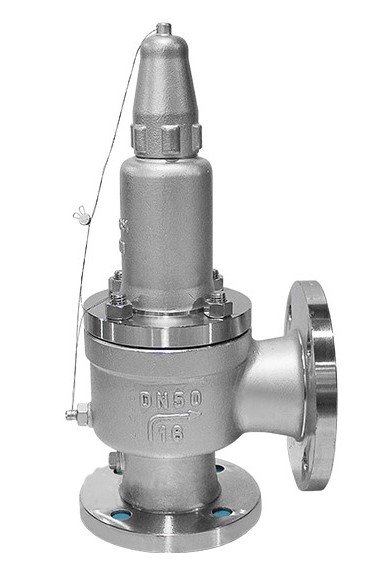Table of Contents
Table of Contents
| Pressure Relief Valve [1] |
|---|
What are Relief Valves?
A relief valve valve is a type of safety valve designed to open at a preset pressure, and discharge fluid until the pressure drops to an acceptable levels level [2]. The valve's valves release of elevated liquid, gas, or steam pressures acts to prevent damage to the system.
Components of a Relief Valve
Relief valves are comprised of three main elements, a valve, a sensing element, and reference force element.
Valve Element
Pressure relief valves often use a spring loaded poppet valve as the valve element [2]. The spring and upstream pressure apply opposing forces on the valve. When the force of the upstream pressure becomes greater force than the spring force, the poppet moves away from the valve seat, allowing fluid to pass through the outlet. As the upstream pressure drops below the set point, the valve will close.
Sensing Element
Piston style designs are often used when higher relief pressures are required [2]. Pistons however, tend to be more sluggish than diaphragm designs, as a result of the friction from the piston seal. In low-pressure applications or when high accuracy is required, the diaphragm style is preferred [2]. Diaphragm relief valves essentially eliminate friction using a thin disc element, typically made of an elastomer, to detect pressure changes [2].
Reference Force Element
The reference force element of a relief valve is commonly a mechanical spring [2]. This spring exerts a force on the sensing element which acts to close the valve. Pressure relief valves are typically designed with an adjustment, allowing the user to adjust the relief pressure set-point by changing the force exerted by the reference spring [2].
| Generic Pressure Release Valve Diagram [3] |
|---|
Types of Relief Valves
Conventional Spring Loaded
With a conventional spring loaded relief valve, the bonnet, spring, and guide are exposed to the released fluids. If the bonnet is vented to the atmosphere, the relief-system back pressure decreases the set pressure [4]. If the bonnet is vented internally to the outlet, the relief-system back pressure increases the set pressure. The conventional spring-loaded valve is used in noncorrosive systems and in which back pressure is less than 10% of the set point [4].
| Conventional Spring Loaded [5] |
|---|
| Advantages | Disadvantages |
|---|---|
|
|
Balanced Spring Loaded
The balanced spring-loaded valve protects the bonnet, spring, and guide from the released fluids and minimizes the effects of back pressure. The disk area vented to the atmosphere is equal to the disk area exposed to back pressure [4]. These relief valves may be used in corrosive or dirty serviceservices, with variable back pressure [4].
| Balanced Spring Loaded [5] |
|---|
| Advantages | Disadvantages |
|---|---|
|
|
Pilot Operated
The pilot - operated relief valve is combined with and controlled by an auxiliary pressure pilot [4]. The resistance force on the piston in the main valve is assisted by the process pressure through an orifice [4]. The net seating force on the piston will increase as the process pressure nears the set point [4].
| Pilot Operated [5] |
|---|
| Advantages | Disadvantages |
|---|---|
|
|
Design Parameters
Relief Pressures
The expected relief pressure is an important consideration when determining the ideal product for the application.
Flow Requirements
The maximum flow rate required by the application, and the possibility for flow rate variation are important considerations [2]. The porting configuration and effective orifices must also be taken into account [2].
Fluid Used
The chemical properties of the fluid to be used with the relief valve must be considered to determine the ideal materials for the application. Care must be taken when selecting materials that will be in contact with the fluid [2].
Size & Weight
Where space is limited, it is important to consider factors such as size and weight. Material, in particular that of the relief valve body components, will affect the weight [2]. Other important considerations include the port (thread) sizes, adjustment styles, and mounting options, all of which will impact the weight [2].
Materials
There are a side wide range of materials available to handle various fluids and operating environments [2]. Common pressure relief valve component materials include brass, plastic, aluminum, and various grades of stainless steel [2]. Springs are often made of music wire (carbon steel) or stainless steel [2]. More details on common pressure relief valve component materials are outlined below.
- Brass - Suitable for most common applications and economical [2]
- Aluminum - Often specified when weight is an important consideration [2]
- Plastic - May be considered when cost is a primary concern or if a throw away item is required [2]
- Stainless Steels steel - Often chosen for corrosive fluids, if fluid cleanliness is a consideration, or for high operating temperatures [2]
Another important material consideration is the compatibility of the seal material with the fluid and the operating temperature range [2]. Buna-N is a common seal material, however some manufacturers may offer seals in Fluorocarbon, EPDM, Silicone and Perfluoroelastomer [2].
Temperature
The relief valve materials must be able to function as intended at the expected operating temperature. More specifically, the primary concern is with the elastomer, which much must function properly throughout the expected temperature range [2]. The operating temperature may also affect the flow capacity, or even the spring rate in extreme conditions [2].
Contributors:
| Contributors Summary | ||||
|---|---|---|---|---|
|
Faculty Advisor: Mary Robinson



